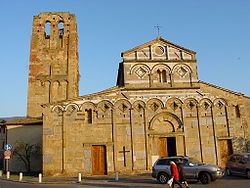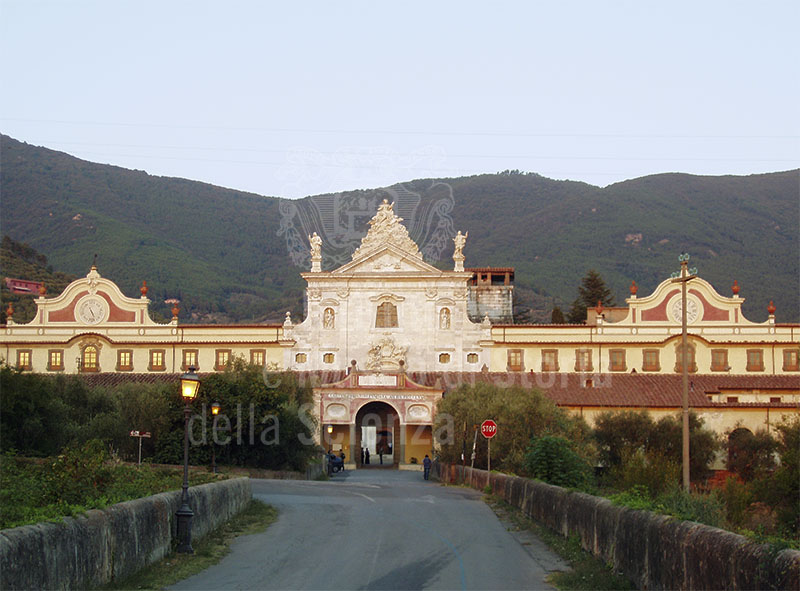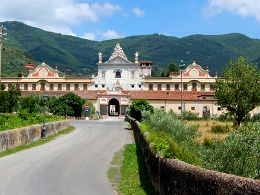Calci
Calci is a municipality with 6428 inhabitants ( 31 December 2012) in the Italian region of Tuscany. It is located in the province of Pisa.
Geography
Calci is located east of the city of Pisa in the small valley Valgraziosa below at the foot of the hills of Monte Pisano and southwest of Monte Serra in the climatic classification of Italian communities in the zone D, GR 1628 / G. The municipality covers 25 km ². It is located about 60 km west of Florence and 9 km east of Pisa. The river divides the city by Zambra and ends shortly after the Arno.
The districts include Gabella (14 meters altitude, about 850 inhabitants), Montemagno (198 meters altitude, about 350 inhabitants), Tiricella (225 meters altitude, about 50 inhabitants) and Villa ( 150 meters, about 40 inhabitants).
The towns of Castel Maggiore, Il Colle, La Corte, La Pieve, Ponte Grande, Rezzano and Tre Colli deemed Borgo ( sub-location ) and administratively belonging to the main town.
The neighboring municipalities are Buti, Cpannori ( LU ), San Giuliano Terme and Vicopisano.
History
In Roman times it was known as locus Calcis (from Latin Calcis for limestone), which points to the numerous quarries in the vicinity. The first mention of the town was in a document of the nearby Abbey of San Savino ( Badia di San Savino ) on 30 April 780. In the Middle Ages, the area belonged to the bishop of Pisa. Several monasteries were founded, and the place lived from agriculture ( as now mainly olives) and textile production ( wool). The forests provided timber for the shipyards of the Maritime Republic of Pisa. Today the church is a popular residential location within the catchment area of Pisa. An important economic factor is the agritourism.
Culture and sights
The Pieve Ss. Giovanni ed Ermolao ( Pieve, built in the 11th century., First mentioned in 1116) has a beautiful facade in the style of the Pisan Romanesque. The Campanile was never completed. Interesting is a marble baptismal font from the 12th century. Also includes two works by Aurelio Lomi (1556-1622), the work of Madonna with Child by Cecco di Pietro ( panel ) and a painted wooden crucifix from the 12th century.
Other important buildings are the Chiesa e convento di Sant'Agostino ( from 1258 to 1264 built ) in the Località Nicosia, by Ugo da Fagiano, Bishop of Nicosia, was taken, and the Santuario della Madonna delle Grazie in Borgo Tre Colli whose church probably originated in the 11th century and was initially dedicated to San Bartolomeo. The Campanile was built from the local tower, which was destroyed in 1288 by Pisa and contains a bell of Nicolò Bondi from the year 1392nd
The Certosa di Pisa is a Carthusian monastery near the village of Calci. It was founded in 1366 and is one of the largest monasteries of Tuscany. In the church of the monastery ( Cappella di San Bruno ) is the Canvas Painting in San Bruno by Jacopo Vignali gloria. The Chiostrino Capitolare houses the fresco by Bernardino Ultima cena Poccetti (1597 originated ). The interior was rebuilt from 1765 to 1795 by the architect Nicola Stassi and decorated with baroque frescoes. Today the monastery is a museum.
In one part of the monastery, the natural history museum Museo di Storia Naturale e del Territorio is housed at the University of Pisa. It shows geological, botanical and zoological collections. It is interesting to a large gallery with 24 whale skeletons.
Among the more famous villas of the community belongs Villa Rosselmini, a pre- 1682 mentioned structure with three gardens south of the town center in Via Rossel Mini 10, and Villa di Crespignano near the castle of Rocca Caprona (the castle is now part of the municipality of Vicopisano ) and the Arnos. The villa was built in the 17th century by the Lanfranchi Lanfreducci family and was considerably altered in 1746 by the architect Ignazio Pellegrini
Pictures
Certosa di Pisa
Certosa di Pisa
Pieve Ss. Giovanni ed Ermolao









